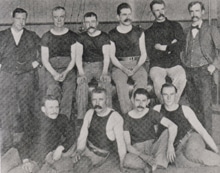It wasn’t always called volleyball.
In fact, while the game that we are familiar with today first took shape in 1895, it would take another half-century for the final version of the the name ‘volleyball’ to become official.
Why is volleyball called volleyball? William G. Morgan may have invented volleyball in 1895, but Alfred T. Halstead is responsible for naming it. After watching one of the first demonstration games, Halstead commented that teams seemed to be ‘volley-ing’ the ball back and forth, and proposed the new name ‘Volley-Ball’.
The original name for the game invented by William G. Morgan in 1895 was ‘Mintonette’.
While working at the YMCA in Holyoke, Massachusetts, USA, Morgan realized that he needed a new way to keep his adult members active and engaged.
In 1895, it seems there weren’t that many options as far as team sports went.
Basketball was still a relatively fresh sport, too, but it was deemed suitable for the younger generation, or so Morgan thought.
‘Mintonette’ was supposed to be the less aggressive solution for older club members: a friendlier version of the sports that Morgan was already familiar with, but one that could include more players.
For a full history of volleyball, check out my article here.
What is Mintonette? (Where did volleyball come from?)
The name Mintonette is derived from another popular game at the time: Badminton.
Morgan thought that his new game resembled badminton, and so the name ‘Mintonette’ (little badminton) seemed appropriate.
Some facts about Mintonette:
1. Mintonette: Invented in 1895
2. Net height: 6ft 6 (198cm) – Slightly taller than the average male at the time.
3. Ball Size and weight: 25-27 inches and between 9 and 12 ounces. (Much lighter than a basketball)
4. No. of players: Unlimited
5. Court size: Undefined, although meant for indoor gymnasiums. (*If you guys have some more information on this, let me know and I’ll add it in!)
When Morgan was still sharpening his ideas for his new game, one big problem was finding the right ball for the job.
The basketball was too heavy, and it was painful to volley around.
He then experimented with just the internal rubber bladders of a few different balls, but it was undeniably too light.
The ball that was first used, then, was actually made specifically at Morgan’s request.
He reached out to the firm of A. G. Spalding & Bros. to make the very first ball for his new game.
Based in Chicopee, Massachusetts, this was the beginning of the Spalding presence in volleyball–still a strong brand in modern volleyball, today.
So why did they call it volleyball?
The name change actually came quite quickly.
After watching the very first demonstration of Morgan’s new game at the YMCA College in Springfield, Professor Alfred T. Halstead proposed that the name ‘Mintonette’ be changed.
He was a big fan of the new game that Morgan had invented, but something was off. It wasn’t really like badminton, and the name didn’t seem to fit.
Instead, he described the movement of the ball as volley-ing back and forth over the net, and he suggested to Morgan that the game be renamed ‘volley-ball’.
He wasn’t wrong.
During the first demonstration, the goal of the game was incredibly simple. Teams were simply required to keep the ball above the height of the net, volleying it to one another however they could.
And it allowed an unlimited number of participants.
Remember, ‘Mintonette’ was primarily invented as a way to keep YMCA members fit and active–the intense competitiveness of modern volleyball would still be in the very distant future.
Morgan approved of the idea immediately, and since this first demonstration was being held at the official YMCA conference at Springfield, it was possible to make the change official.
‘Mintonette’ was changed to ‘Volley-Ball’, and a new game was written into the YMCA rulebook by 1897.
So who named ‘volleyball’? Alfred T. Halstead seems the best candidate for this honor, although technically it was the entire YMCA conference that agreed upon the name ‘Volley-Ball’.
But that isn’t quite the end of the ‘volleyball’ story, is it…
From Volley-Ball to Volleyball
Up until 1952, the official name of this great sport was Volley-Ball.
Dash included.
While this sounds like a minor detail, it explains why some federations still hold a trace of the original name in their acronyms: FIVB for example, as opposed to FIV…
It wasn’t until 1952 that the dash was removed, and we were given the familiar name we see today: volleyball.
So how did volleyball become known as volleyball?
From Mintonette to volleyball, the history of volleyball has been far more interesting than its name. Today, it is one of the 5 most popular sports in the world, and it consistently draws the largest audience of any team sport at the Olympic Games.
Summing Up
For a more detailed history of volleyball, its origins and its standing in global sport today, take a look at my full history of volleyball.
Otherwise, I hope this post answered your volleyball naming questions, and that you found it useful!
